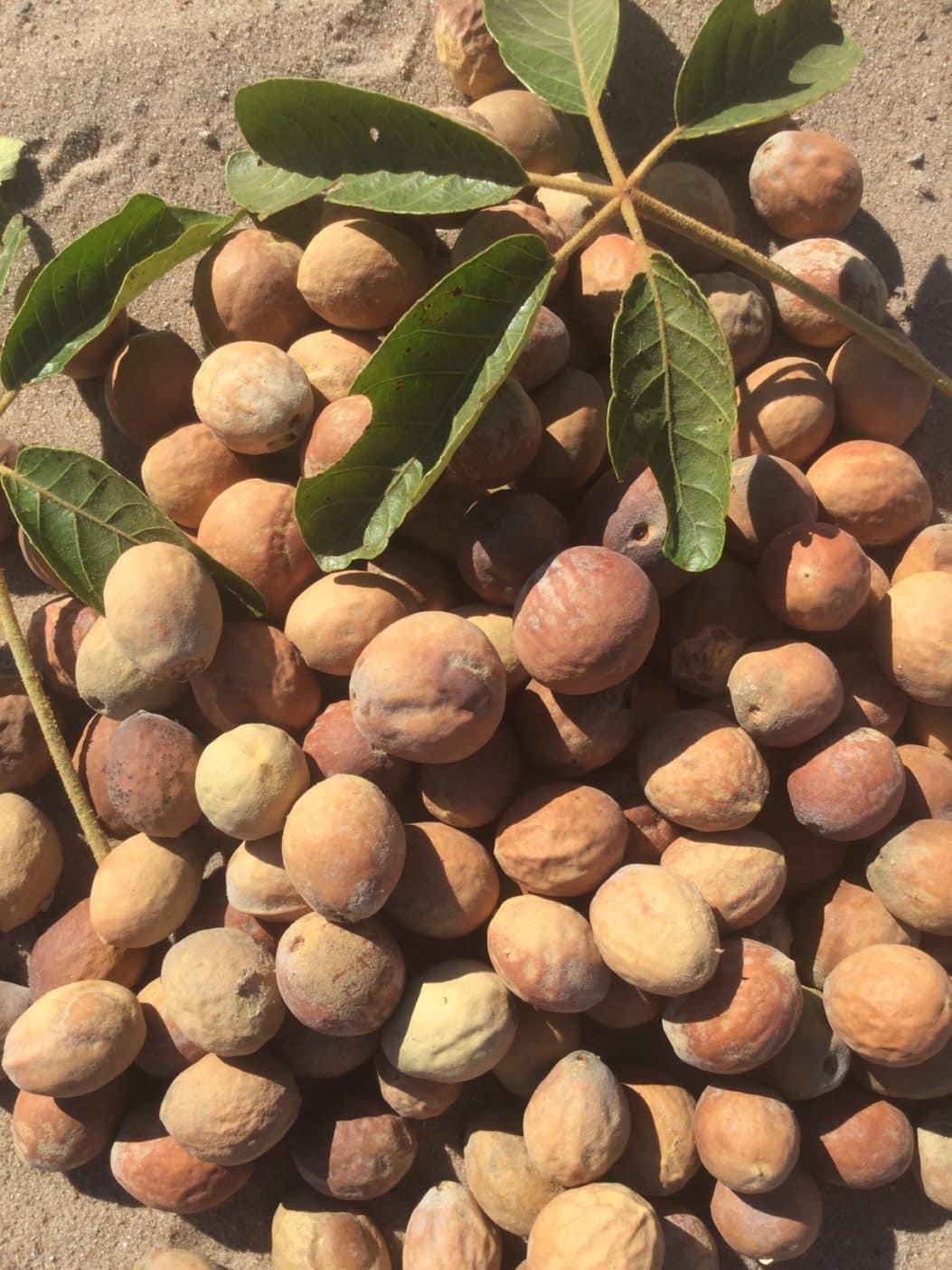Mongongo oil

The Mongongo tree (Schinziophyton rautanenii) is native to the African savannah and the Kalahari, where it defies extreme climatic conditions and is a popular shade tree. It can grow up to 20 metres high, its wood is light yellow, very hardy and light. The mongongo tree produces pretty yellow flowers in October and November. It is striking that it only starts to bear fruit after about 25 years. These are oval, about the size of plums and initially green, later yellowish-brown to red. They ripen between February and April, their flesh is spongy, relatively dry, tasty, and very nutritious. For the indigenous tribes, the fruits of the Mongongo tree are therefore also an important staple food. Archaeological findings have even shown that they have been part of the traditional eating habits of the Kalahari people for more than 7000 years. Inside the fruit are seeds or nuts. They are so hard that even elephants have difficulty cracking them and can be stored for a long time without spoiling. The seeds contained are up to two centimetres in size, elliptical to round and also very hard. By extracting them, a valuable oil can be obtained from them: mongongo oil.
Mongongo oil and its benefits
African women have been using mongongo oil for body care for centuries. It is considered a real beauty secret weapon and its positive properties are passed on from generation to generation. The composition is indeed impressive: Mongongo oil is very rich in vitamin E, but also contains considerable amounts of calcium, magnesium, zinc, copper, and iron. The unsaturated fatty acids contained are also worthy of mention. This cocktail of active ingredients makes mongongo oil a wonderful skin and hair care product. It provides a lot of moisture, has a soothing effect and is still completely natural. As an antioxidant, vitamin E prevents premature skin ageing by protecting against cell damage. It also contributes to the regeneration of the epidermis. The polyunsaturated fatty acids, on the other hand, can smooth fine lines and wrinkles and make the skin look plumper and more supple. The other nutrients also contribute to a fresh youthful complexion. Mongongo oil therefore gives a vibrant, beautiful glow and is a real boon for the skin.
However, it is at least as suitable for hair care. The British star hairdresser Lee Stafford knows this, too, and has already discovered mongongo oil for his luxury products. Mongongo oil strengthens the hair, adds shine and volume, and soothes stressed or sensitive scalps. The valuable African oil can even protect against harmful UV rays to a certain extent. Brittle hair particularly benefits from mongongo oil.
The uses of mongongo oil are extremely versatile. It is ideal for moisturising face creams, body lotions and care oils as well as for shower and bath products, shampoos, and hair conditioners. It can also play out its benefits perfectly in a massage oil.
Sustainable and fairly produced
African women have been using what nature has to offer them for centuries. They have a valuable knowledge that has been expanded and supplemented over the course of time. We can all benefit from this knowledge. We work closely with “Namib Desert Jojoba”, a company that attaches great importance to sustainable and socio-ecological cultivation. It supports communal farmers in establishing their own plantation as well as well over 1000 Namibian women who are at home in rural regions of the country. The women usually take over the harvesting of the fruits: a task that is easy to manage, as the fruits usually fall from the trees already green and ripen on the ground. They then only have to be picked up. The commitment of our partner offers many local families a secure income and a fair chance for a good future.
In order to produce a high-quality product at all times, the Mongongo oil is extracted under special conditions and with a German technology. Strict quality controls and laboratory tests take place regularly.
Our Mongongo oil from the Kamasa tribe is virgin and has been cold pressed. Of course, it is free of parabens, mineral oil, and PEG. The compatibility is very good, the oil leaves a very pleasant feeling on the skin. However, it is not edible for humans.
Fact Sheet Mongongo Oil
Alternative name: Manketti oil
Origin and production: from the seeds of the tree Schinziophyton rautanenii, which belongs to the spurge family (Euphorbiaceae) and is mainly native to Namibia.
INCI: Schinziophyton Rautaneii Seed Oil
Description: Light yellow oil with a typical nutty smell
Main ingredients: vitamin E (tocopherol), linoleic acid, eleostearic acid, zinc, iron, magnesium, calcium, copper
Effect: moisturising, antioxidant, calming, regenerating
Possible uses: Creams, lotions, care oils, massage oils, shower and bath products, hair care products
High-quality mongongo oil for sophisticated cosmetic products
Mongongo oil is currently still considered exotic among cosmetic raw materials, but due to its valuable ingredients and its many positive properties, it is increasingly gaining ground. When using it, however, it is essential to pay attention to fair, sustainable, and responsible cultivation under socio-ecological aspects. It is also important that the oil is free of chemical additives. Are you interested in first-class cosmetic and care products with Mongongo oil? Cosmacon will be happy to assist you in developing modern formulations!
Literature:
Frankova A, Manourova A, Kotikova Z, Vejvodova K, Drabek O, Riljakova B, Famera O, Ngula M, Ndiyoi M, Polesny Z, Verner V, Tauchen J.Molecules. 2021 Aug 27;26(17):5210